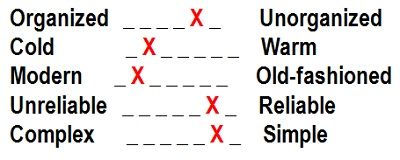Definition: The Semantic Differential Scale is a seven-point rating scale used to derive the respondent’s attitude towards the given object or event by asking him to select an appropriate position on a scale between two bipolar adjectives (such as “warm” or “cold”, “powerful” or “weak”, etc.)
For example, the respondent might be asked to rate the following five attributes of shoppers stop by choosing a position on a scale between the adjectives that best describe what really the shoppers stop means to him.

The respondent will place a mark anywhere between the two extreme adjectives, representing his attitude towards the object. Such as, in the above example, the shoppers stop is evaluated as organized, cold, modern, reliable and simple.
Sometimes the negative adjectives are placed on the right and sometimes on the left side of a scale. This is done to control the tendency of the respondents, especially those with either very positive or negative attitudes, to mark the right or left-hand sides of a scale without reading the labels.
The items on a semantic differential scale can be scored on either a numerical range of -3 to +3 or 1 to 7. The data obtained are analyzed through profile analysis. In profile analysis, the means and medians of the scale values are found out and then are compared by plotting or statistical analysis. Through this method, it is possible to compare the overall similarities and differences among the objects.
The versatility of the semantic differential scale increases its application in the marketing research. It is widely used in comparing the brand, company image, and product. It also helps in developing an advertising campaign and promotional strategies in new product development studies.

Leave a Reply